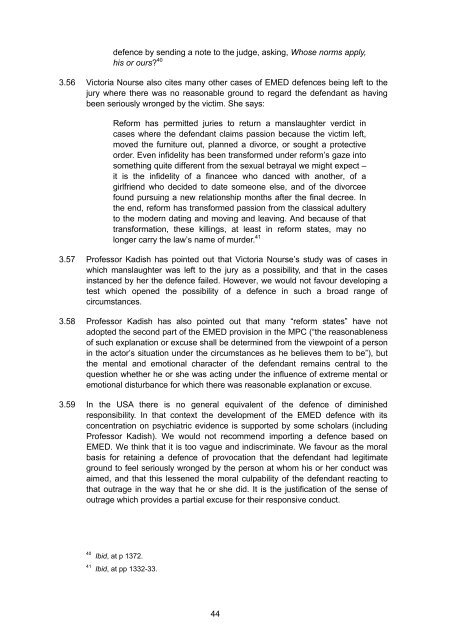lc290 Partial Defences to Murder report - Law Commission
lc290 Partial Defences to Murder report - Law Commission
lc290 Partial Defences to Murder report - Law Commission
Create successful ePaper yourself
Turn your PDF publications into a flip-book with our unique Google optimized e-Paper software.
defence by sending a note <strong>to</strong> the judge, asking, Whose norms apply,<br />
his or ours? 40<br />
3.56 Vic<strong>to</strong>ria Nourse also cites many other cases of EMED defences being left <strong>to</strong> the<br />
jury where there was no reasonable ground <strong>to</strong> regard the defendant as having<br />
been seriously wronged by the victim. She says:<br />
Reform has permitted juries <strong>to</strong> return a manslaughter verdict in<br />
cases where the defendant claims passion because the victim left,<br />
moved the furniture out, planned a divorce, or sought a protective<br />
order. Even infidelity has been transformed under reform’s gaze in<strong>to</strong><br />
something quite different from the sexual betrayal we might expect –<br />
it is the infidelity of a financee who danced with another, of a<br />
girlfriend who decided <strong>to</strong> date someone else, and of the divorcee<br />
found pursuing a new relationship months after the final decree. In<br />
the end, reform has transformed passion from the classical adultery<br />
<strong>to</strong> the modern dating and moving and leaving. And because of that<br />
transformation, these killings, at least in reform states, may no<br />
longer carry the law’s name of murder. 41<br />
3.57 Professor Kadish has pointed out that Vic<strong>to</strong>ria Nourse’s study was of cases in<br />
which manslaughter was left <strong>to</strong> the jury as a possibility, and that in the cases<br />
instanced by her the defence failed. However, we would not favour developing a<br />
test which opened the possibility of a defence in such a broad range of<br />
circumstances.<br />
3.58 Professor Kadish has also pointed out that many “reform states” have not<br />
adopted the second part of the EMED provision in the MPC (“the reasonableness<br />
of such explanation or excuse shall be determined from the viewpoint of a person<br />
in the ac<strong>to</strong>r’s situation under the circumstances as he believes them <strong>to</strong> be”), but<br />
the mental and emotional character of the defendant remains central <strong>to</strong> the<br />
question whether he or she was acting under the influence of extreme mental or<br />
emotional disturbance for which there was reasonable explanation or excuse.<br />
3.59 In the USA there is no general equivalent of the defence of diminished<br />
responsibility. In that context the development of the EMED defence with its<br />
concentration on psychiatric evidence is supported by some scholars (including<br />
Professor Kadish). We would not recommend importing a defence based on<br />
EMED. We think that it is <strong>to</strong>o vague and indiscriminate. We favour as the moral<br />
basis for retaining a defence of provocation that the defendant had legitimate<br />
ground <strong>to</strong> feel seriously wronged by the person at whom his or her conduct was<br />
aimed, and that this lessened the moral culpability of the defendant reacting <strong>to</strong><br />
that outrage in the way that he or she did. It is the justification of the sense of<br />
outrage which provides a partial excuse for their responsive conduct.<br />
40 Ibid, at p 1372.<br />
41 Ibid, at pp 1332-33.<br />
44

















